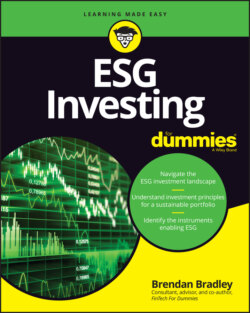Читать книгу ESG Investing For Dummies - Brendan Bradley - Страница 13
Exploring What ESG Is (and Isn’t)
ОглавлениеIn recent years, the term “ESG” has generally become synonymous with socially responsible investment. However, ESG should be seen as more of a risk management framework for evaluating companies and not as a stand-alone investment strategy. ESG measures the sustainability and societal impact of an investment in a company. These criteria help better determine the future financial performance of companies. Likewise, impact investing is more about the type of investments a manager is targeting, while ESG factors are part of an assessment process to apply non-financial factors to a manager’s analysis in identifying material risks and growth opportunities. Also, impact investing seeks to make a measurable, positive, environmental, or social effect with the investments that a fund manager purchases, whereas ESG is a “means to an end,” serving to identify non-financial risks that may have a material impact on an asset’s value.
Moreover, ESG is often incorrectly commingled with terms such as corporate sustainability and corporate social responsibility (CSR). While some overlap exists, these terms aren’t interchangeable:
Corporate sustainability is an umbrella term used to describe the long-term creation of stakeholder value by encompassing opportunities and managing risks resulting from economic, environmental, and social developments. To many companies, corporate sustainability is about “doing good” and doesn’t require any set conditions.
Corporate social responsibility is an embedded management concept where companies incorporate the concerns of key stakeholders into their operations and activities. In comparison, ESG assesses a company’s ESG practices, together with more traditional financial measures.
Finally, ESG is also commonly intermingled with ethical investing. However, taking an ESG approach is effectively a precursor to the point of investing. It provides a framework that allows you to consider ‘E,’ ‘S,’ and ‘G’ issues facing a company and to score them either individually or collectively to identify where they sit relative to each other. This leads investors to consider stocks that may be “best-in-class” from an ESG score perspective or exclude them entirely because, for example, their environmental score doesn’t reflect their values. Ethical investing involves selecting investments based on ethical or moral principles. Such investors typically avoid “sin stocks,” such as those related to gambling, alcohol, or firearms, which can be implemented via an ESG exclusions strategy (where sin stocks are explicitly excluded from a portfolio).
You may be used to gauging financial ratios when investing in stocks, from the relative price-to-earnings (P/E) ratio to EBITDA margins. (Yes, I’m talking about earnings before interest, taxes, depreciation, and amortization — good thing there’s an acronym to use.) All of those ratios are still relevant, but now you can view the same stocks through an additional lens. The sustainability evaluation of ratings firms is normally blended into a single ESG score, similar to the stock recommendations offered by investment banks and brokers. Just as mainstream research analysts calculate different recommendation valuations for the same companies, using largely the same information, so ESG analysts also differ on their recommended scores. Check out Chapter 2 for an introduction to ESG ratings.
The following sections look at the different components of ESG, including financially material indicators, how those indicators can differ according to industry sector, and how various ESG strategies can be applied across these factors. These elements can be analyzed in the ESG Cube, which represents the intersections between these factors.
